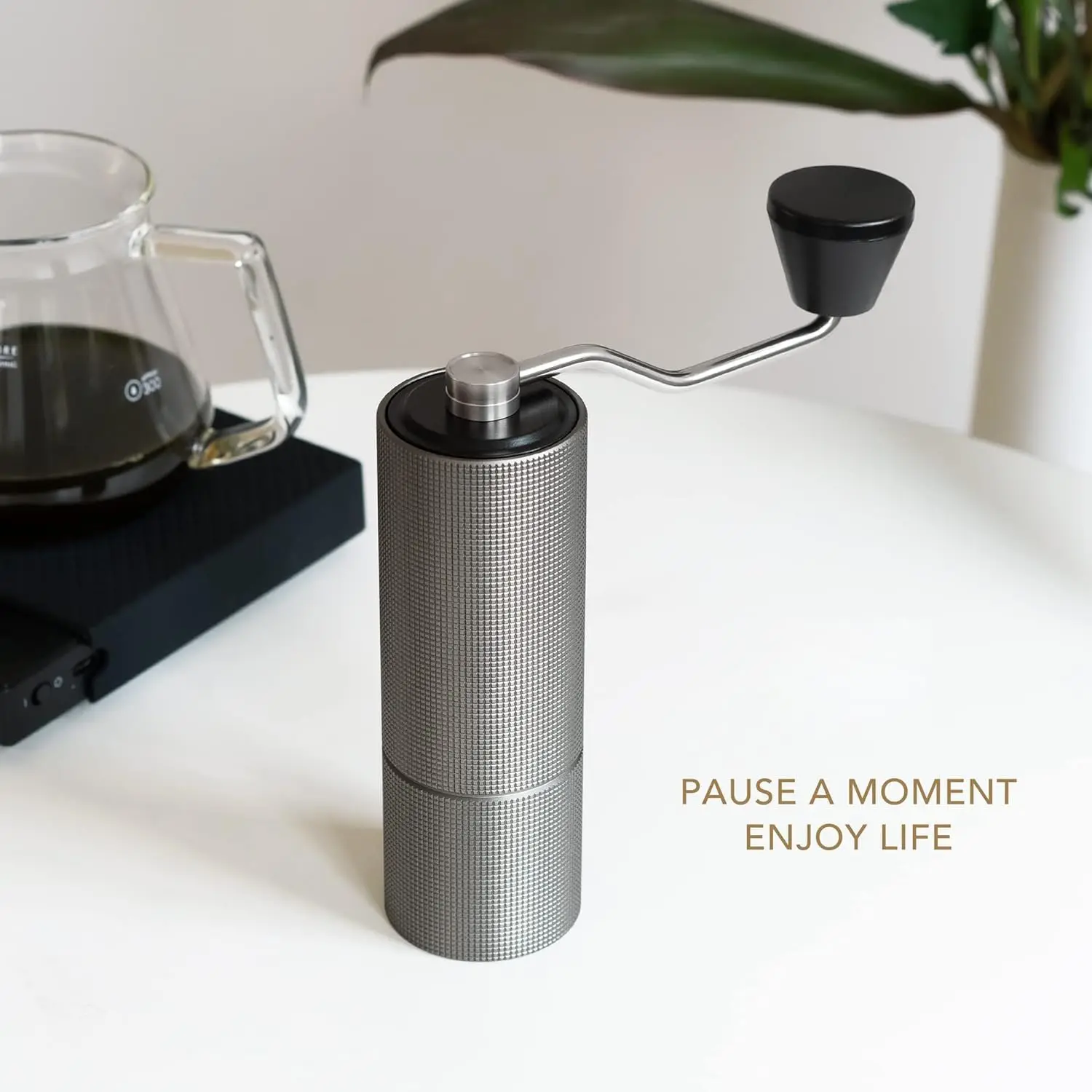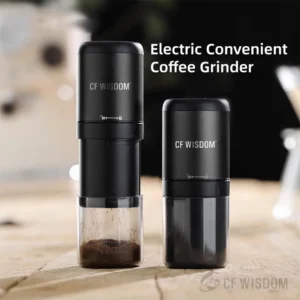Introduction: The Enduring Appeal of Full-Metal Manual Grinders
There’s something deeply satisfying about grinding coffee by hand. The ritual connects you directly to your brewing process, offering unparalleled control over your grind size while engaging all your senses. When it comes to manual grinding, the materials used in construction significantly impact both performance and longevity—and this is where full-metal housing grinders truly shine.
Full-metal housing isn’t just about premium aesthetics (though they certainly look impressive on any countertop). This construction choice fundamentally affects everything from grind consistency to the overall lifespan of your investment. Metal construction provides stability during grinding, resulting in more uniform coffee particles that extract evenly and produce better-tasting brews.
In this comprehensive guide, we’ll explore the substantial benefits of investing in all-metal coffee grinder designs that combine durability with precision engineering. We’ll examine specific features to look for, compare top models, and help you understand why serious coffee enthusiasts often reach for these sturdy tools that deliver exceptional results cup after cup.
The growing popularity of manual brewing methods has only increased demand for tools that offer both tactile satisfaction and outstanding performance. Unlocking grind consistency with all-metal manual coffee grinders means accessing a level of brewing precision that can transform your daily coffee ritual.
What Defines a “Full-Metal Housing” Grinder?
Before diving deeper, let’s clarify exactly what constitutes a true “full-metal housing” grinder. This term refers to manual coffee grinders where the main structural components—particularly the grinding chamber and external body—are constructed entirely from metal materials.
A genuine full-metal grinder typically includes:
- Metal exterior body/casing (typically aluminum or stainless steel)
- Metal grinding chamber that houses the burrs
- Metal catch cup/grounds container
- Metal internal support structures and stabilizing components
- Metal adjustment mechanisms
It’s important to note that not all “metal” grinders are created equal. Some manufacturers advertise “metal construction” when only certain components use metal materials. True all-metal hand grinders feature comprehensive metal construction throughout all critical components.
To identify authentic full-metal construction when shopping:
- Check the weight (full-metal grinders are typically heavier)
- Examine product descriptions for specific mentions of materials used in each component
- Look for terms like “all-metal pathway” indicating that coffee only contacts metal surfaces
- Assess if any plastic components are used in structural elements (versus just knobs or accents)
The distinction matters because it directly impacts both performance and longevity, making proper identification crucial when investing in a premium manual grinder.
Key Benefits of Full-Metal Construction in Manual Grinders
Superior Durability and Longevity
The most obvious advantage of full-metal construction is exceptional durability. While plastic grinders might crack, warp, or wear down over time, metal grinders resist daily wear and occasional drops with remarkable resilience. This robustness translates directly to longevity—a quality full-metal grinder can last decades with proper maintenance, making it a true buy-it-once purchase.
Enhanced Stability During Grinding
The rigid nature of metal housing minimizes flex and vibration during grinding. This stability is crucial because any movement or wobble in the grinding mechanism directly impacts grind consistency. Metal construction provides a solid foundation that helps maintain precise burr alignment even under pressure, resulting in more uniform coffee particles that extract evenly.
Improved Grind Consistency
Perhaps the most important benefit for coffee quality is improved grind consistency. The structural integrity of metal versus plastic hand grinder construction ensures that the burrs maintain perfect alignment throughout the grinding process. This alignment precision means fewer fines (too-small particles that cause bitterness) and boulders (too-large particles that lead to sourness or underdeveloped flavors).
Premium Tactile Experience
The substantial weight and solid feel of a metal grinder provides a satisfying tactile experience that plastic alternatives simply cannot match. The heft gives stability during grinding, while the cool touch of metal and mechanical precision of the components creates a sensory experience that enhances the coffee ritual.
Better Heat Management
Metal’s superior heat conductivity helps dissipate the friction heat generated during grinding more effectively than plastic. This heat management is particularly valuable when grinding for espresso or other methods requiring fine grounds, as excessive heat can potentially impact flavor compounds in the coffee.
Easier Cleaning and Maintenance
Non-porous metal surfaces resist coffee oil buildup and are generally easier to clean thoroughly. Unlike plastic, which can develop micro-scratches that harbor stale coffee oils, metal surfaces maintain their integrity and clean appearance with minimal effort, contributing to better-tasting coffee over time.
Materials Used in Premium Manual Grinder Construction
The specific metals used in grinder construction significantly impact performance, weight, and longevity. Here’s a breakdown of common materials and their properties:
Stainless Steel Varieties
Stainless steel represents the gold standard for many premium manual grinders. Its corrosion resistance, durability, and food-safe properties make it ideal for coffee applications. Understanding stainless steel coffee grinder durability helps explain why this material commands premium pricing.
The most common varieties include:
- 304 Stainless Steel: Food-grade, highly resistant to corrosion, and durable enough for daily use
- 420 Stainless Steel: Often used for burrs due to its hardness and edge retention
- 316 Stainless Steel: Premium marine-grade steel with exceptional corrosion resistance (rare in grinders but occasionally used for premium models)
Aluminum and Aluminum Alloys
Aircraft-grade aluminum offers an excellent strength-to-weight ratio, making it popular for grinders designed with portability in mind. Anodized aluminum provides enhanced durability with a scratch-resistant finish that comes in various colors. The lightweight nature of aluminum makes it particularly suitable for travel grinders where every ounce matters.
Specialty Metals and Alloys
Some premium grinders incorporate:
- Brass Components: Often used for bearing assemblies and aesthetic elements
- Zinc Alloys: Provides strength with detailed casting potential for complex parts
- Titanium Coatings: Sometimes applied to burrs for enhanced hardness and longevity
Common Material Combinations
Many high-end grinders combine different metals strategically:
- Stainless steel burrs within aluminum bodies for optimal weight distribution
- Brass bearings within stainless assemblies for smooth operation
- Titanium-coated burrs within stainless grinding chambers for performance and longevity
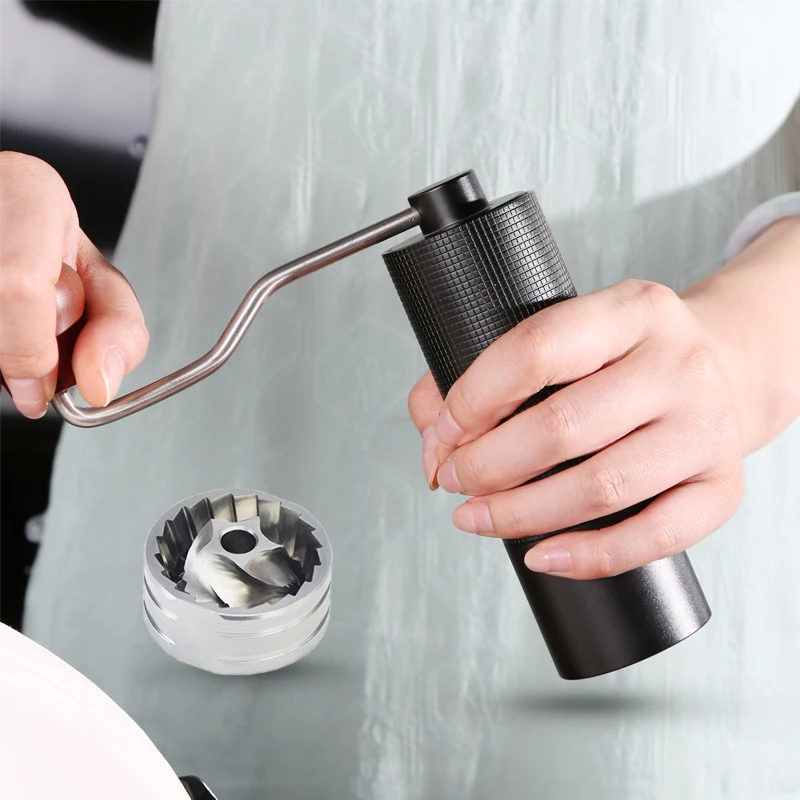
The stainless steel manual coffee grinders category continues to expand with innovations in material applications and engineering approaches that enhance both functionality and aesthetics.
How Metal Housing Affects Grinding Performance
The choice of metal housing affects far more than just durability—it fundamentally shapes grinding performance in several critical ways:
Burr Stability and Alignment
Metal housing provides superior structural rigidity, which directly supports consistent burr alignment. This precision engineering ensures that the distance between burrs remains uniform throughout the grinding motion. Even minor flexing in the housing can cause the burrs to shift slightly during grinding, resulting in inconsistent particle size—a problem effectively eliminated by quality metal construction.
Consistent Grind Particle Distribution
The stability of metal construction translates directly to more consistent grind particles. This uniformity is particularly critical for brewing methods like espresso and pour-over, where particle size distribution significantly impacts extraction quality. Metal housing minimizes vibration and movement during grinding, resulting in narrower particle size distribution.
Grinding Efficiency and Effort
While metal grinders are typically heavier than plastic alternatives, the superior engineering and stability they offer can actually reduce the effort required to grind beans. The precision-machined components create smooth operation with minimal resistance, while the weight provides stability that helps maintain momentum during grinding.
Performance Across Grind Settings
The rigid construction of metal grinders maintains consistency regardless of grind setting. This versatility is particularly valuable for coffee enthusiasts who brew using multiple methods, from fine espresso grinds to coarse French press settings. The structural integrity ensures that adjustments remain precise and repeatable—critical for developing and refining brewing recipes.
Top 5 Full-Metal Manual Coffee Grinders Compared
The market for premium metal coffee grinders continues to evolve with innovations in design and engineering. Here’s a comparative look at five standout models that showcase the best of full-metal construction:
Grinder 1: Precision Traveler
This compact marvel features aerospace-grade aluminum housing with stainless steel internal components. Despite its travel-friendly size, it incorporates 38mm hardened steel conical burrs that deliver exceptional grind consistency. The innovative magnetic catch cup and foldable crank handle make it particularly suitable for travelers without sacrificing performance.
Grinder 2: Classic Professional
Constructed entirely from brushed stainless steel, this grinder offers exceptional stability and heft. Its 47mm professional-grade conical burrs and stepless adjustment system provide unparalleled versatility across brewing methods. The extended handle creates excellent leverage for effortless grinding, while the substantial capacity accommodates larger batches when needed.
Grinder 3: Precision Titan
This premium offering features titanium-coated steel burrs within a unibody stainless steel frame. The innovative dual bearing system virtually eliminates wobble during grinding, resulting in exceptional particle uniformity. Its stepped adjustment mechanism provides clear tactile feedback with 40 distinct settings, making it ideal for methodical brewers seeking repeatability.
Grinder 4: Artisan Heritage
Combining brushed stainless steel with hand-finished walnut accents, this grinder balances modern performance with classic aesthetics. The 38mm conical burrs deliver consistent grinds, while the unique external adjustment ring allows for precise settings without disassembly. Its medium capacity and elegant design make it perfect for dedicated home use.
Grinder 5: Ultra-Portable Element
This minimalist design proves that compact doesn’t mean compromising quality. Constructed from aircraft-grade aluminum with stainless internals, it weighs under 12 ounces while still incorporating 38mm steel burrs. The simplified adjustment system offers 15 clearly defined settings optimized for manual brewing methods.
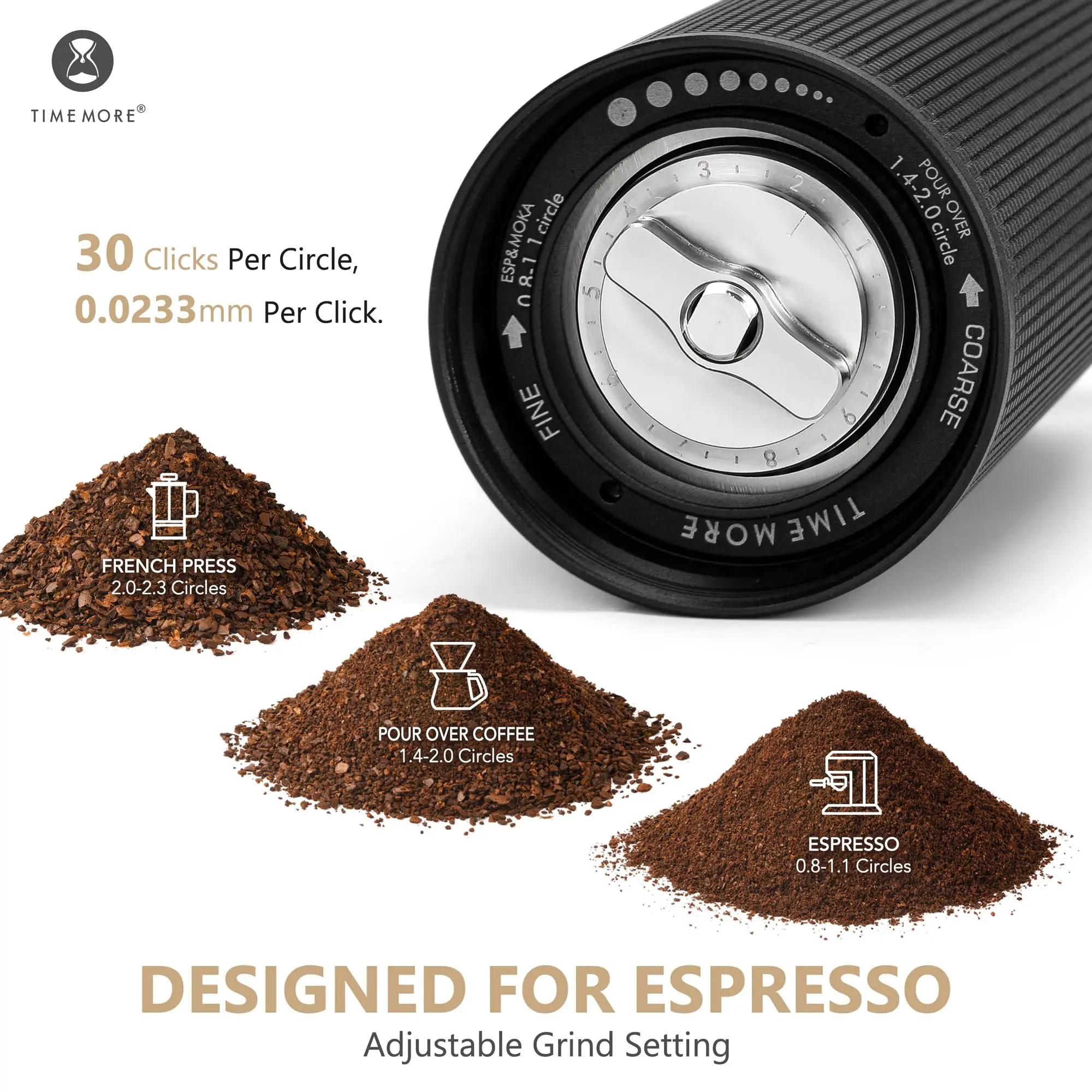
| Feature | Grinder 1 | Grinder 2 | Grinder 3 | Grinder 4 | Grinder 5 |
|---|---|---|---|---|---|
| Housing Material | Aluminum | Stainless Steel | Stainless Steel | Stainless Steel/Walnut | Aluminum |
| Burr Type/Size | 38mm Steel Conical | 47mm Steel Conical | 48mm Titanium-Coated | 38mm Steel Conical | 38mm Steel Conical |
| Capacity | 20g | 40g | 35g | 30g | 20g |
| Weight | 11.5 oz | 24 oz | 27 oz | 22 oz | 10 oz |
| Price Range | $$ | $$$ | $$$$ | $$$ | $$ |
| Best For | Travel | Versatility | Precision | Home Use | Minimalist Travel |
Essential Features Beyond the Housing
While full-metal housing provides the foundation for quality, several other features contribute significantly to overall performance:
Burr Materials and Designs
The heart of any grinder is its burr set. The debate between flat vs conical burr manual grinders continues, with each offering distinct advantages:
- Conical Burrs: More common in manual grinders, these require less torque, produce less heat, and excel at brew methods from pour-over to French press
- Flat Burrs: Less common in manual designs but provide extremely consistent particle size, particularly valuable for espresso
Burr materials matter tremendously:
- Hardened stainless steel offers excellent durability and performance
- Titanium-coated steel provides enhanced hardness and longevity
- Ceramic burrs generate less heat but may be more brittle
Grind Adjustment Mechanisms
The adjustment system directly impacts usability and precision:
- Stepped Adjustment: Offers clear, repeatable settings with audible/tactile clicks
- Stepless Adjustment: Provides infinite adjustment for absolute precision, particularly valuable for espresso
- External Adjustment: Allows changes without disassembling the grinder
- Internal Adjustment: Often more stable but requires partial disassembly to modify
Handle Design and Ergonomics
The handle design significantly affects grinding comfort:
- Length (longer handles provide better leverage)
- Material (wood, metal, or composite)
- Foldability for travel models
- Grip design and comfort
Additional Practical Considerations
Other important factors include:
- Bearing quality and quantity (more bearings typically mean smoother operation)
- Capacity (typically ranges from 15g to 50g)
- Ease of disassembly for cleaning
- Overall dimensions and portability
Practical Considerations When Choosing a Full-Metal Grinder
How much should I expect to invest in a quality full-metal grinder?
Quality full-metal grinders typically start around $100, with premium models ranging from $150 to $300+. Consider this an investment—quality grinders maintain their performance for decades, effectively making them much less expensive than lower-quality grinders that require replacement.
How do I balance durability against portability needs?
Weighing options in metal coffee grinders involves honest assessment of your priorities. If you travel frequently, aluminum construction offers substantial durability at lower weight. For home use where the grinder rarely moves, the additional stability of heavier stainless steel might be preferable. Some manufacturers now offer compact models specifically designed for both durability and portability.
What maintenance will my metal grinder require?
Most metal grinders need minimal maintenance—regular brushing of grounds from burrs, occasional deep cleaning, and periodic burr alignment checks. Stainless steel requires virtually no special care, while aluminum might benefit from gentle handling to avoid dents or scratches.
Is there a learning curve with manual metal grinders?
Most quality manual grinders feature intuitive designs, though each model has unique adjustment mechanisms and optimal grinding techniques. Expect a short period (1-2 weeks of daily use) to develop comfort with the specific motion and settings of your chosen grinder.
How can I determine the right capacity for my needs?
Consider your typical brewing amount. For single cups, a 20g capacity is often sufficient. For couples or multiple consecutive brews, look for 30g+ capacity. Remember that grinding multiple batches is always an option, but can disrupt workflow if frequent.
Fine Adjustment Hand Grinder, Precision Manual Grinder, Travel Coffee Grinder
Price range: $185.11 through $494.63 Select options This product has multiple variants. The options may be chosen on the product pageManual Burr Mill, Manual Coffee Grinder Stainless Steel, Manual Coffee Mill Grinder, Mechanical Coffee Grinder
Price range: $127.26 through $130.32 Select options This product has multiple variants. The options may be chosen on the product pageHand Burr Grinder, Manual Coffee Grinder Stainless Steel, Precision Manual Grinder
Price range: $183.64 through $187.52 Select options This product has multiple variants. The options may be chosen on the product pageManual Coffee Grinder Stainless Steel, Manual Espresso Grinder, Travel Coffee Grinder
Price range: $276.22 through $276.39 Select options This product has multiple variants. The options may be chosen on the product page
Care and Maintenance for Long-Term Performance
Proper maintenance ensures your investment continues delivering exceptional performance for years to come:
Daily Quick-Clean Routine
- Brush visible grounds from the burrs and grinding chamber
- Wipe exterior surfaces with a dry cloth
- Turn the grinder upside down and run briefly to clear residual particles
- Store in a dry location away from direct sunlight
Monthly Deep Clean Process
- Fully disassemble following manufacturer instructions
- Brush all components thoroughly, paying special attention to burrs
- Use compressed air (optional) to remove particles from hard-to-reach areas
- Wipe metal components with a slightly damp cloth
- Allow to fully dry before reassembling
Special Considerations for Metal Surfaces
Different metals require slightly different care approaches:
- Stainless steel: Wipe with a soft cloth; avoid abrasive cleaners
- Aluminum: Handle gently to prevent dents; avoid alkaline cleaners
- Anodized finishes: Clean with mild soap if necessary; avoid abrasive materials
The manual burr grinder maintenance guide offers in-depth procedures for preserving optimal performance across different grinder types and materials.
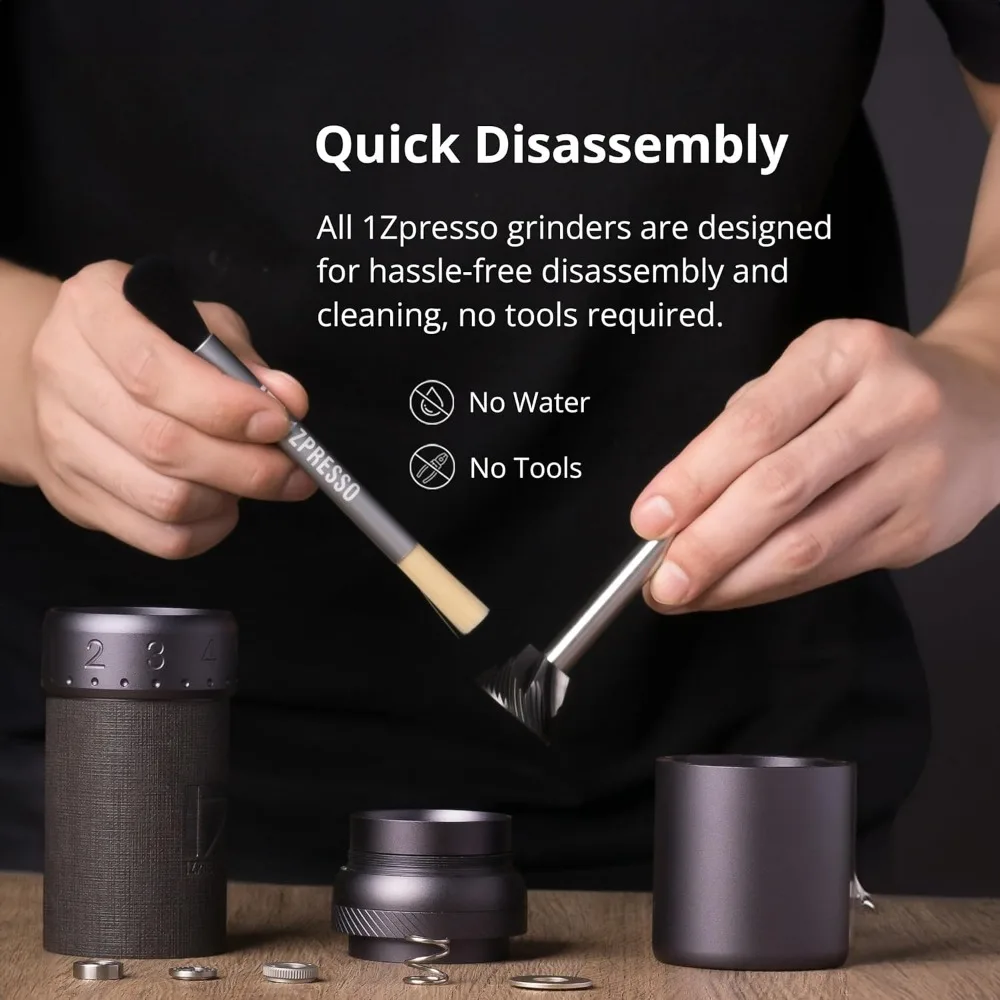
Are Full-Metal Grinders Worth the Investment?
Considering the substantial price difference between plastic and full-metal grinders, it’s reasonable to question the value proposition. The answer depends largely on your coffee journey and priorities:
For occasional coffee drinkers satisfied with basic quality, the premium price might be difficult to justify. However, for anyone who appreciates the nuances of specialty coffee, the investment delivers tangible benefits in both cup quality and long-term value.
The mathematics of longevity make a compelling argument—a quality metal grinder costing $200 that lasts 20+ years represents just $10 per year or less than $1 per month. Meanwhile, plastic alternatives might require replacement every 3-5 years, potentially costing more over time while delivering inferior results.
The performance advantages are equally significant. The enhanced stability and precision of all-metal coffee grinders result in noticeably better extraction, fuller flavors, and more consistency cup after cup. For many enthusiasts, this daily improvement in quality represents the most persuasive justification for the initial investment.
How to Identify Quality in Full-Metal Grinders
Not all metal grinders deliver equal quality. Here’s how to assess true craftsmanship:
Visual and Tactile Quality Indicators
- Smooth, consistent finish without irregularities
- Tight tolerances where components meet
- Consistent coloration throughout metal surfaces
- No visible casting marks or rough edges
- Substantial weight that suggests solid construction
Movement and Mechanism Tests
- Smooth rotation with minimal resistance
- No lateral play in the main shaft
- Consistent adjustment clicks (for stepped mechanisms)
- Fluid handle movement without binding
- Stability when placed on flat surfaces
Red Flags to Watch For
- Excessive rattling when shaken
- Inconsistent gaps between components
- Sharp edges that suggest poor finishing
- Misaligned threads or difficult assembly
- Lightweight construction despite full-metal claims
When shopping from manual coffee grinder stainless steel collections, these quality indicators help distinguish truly premium offerings from merely adequate options.
FAQs About Full-Metal Manual Coffee Grinders
Are full-metal grinders suitable for travel?
Yes, though with considerations. While heavier than plastic alternatives, many manufacturers now offer compact all-metal grinders for coffee enthusiasts specifically designed for travel with features like foldable handles, reduced weight through strategic material choices, and protective cases. Aluminum models typically offer the best balance of durability and weight for frequent travelers.
Can full-metal grinders rust or corrode?
Quality stainless steel grinders resist corrosion exceptionally well under normal conditions. Aluminum models with proper anodization are also highly resistant to corrosion. However, extended exposure to moisture or certain cleaning chemicals could potentially affect any metal over time. Simple precautions—drying thoroughly after cleaning and avoiding harsh chemicals—virtually eliminate any corrosion risk.
How much heavier are metal grinders compared to alternatives?
Metal grinders typically weigh 2-3 times more than plastic alternatives of similar capacity. For example, a plastic-cased manual grinder might weigh 8-10 ounces, while a comparable metal model would likely weigh 16-24 ounces. This additional weight contributes to stability during grinding but may be a consideration for travelers.
Do metal grinders affect coffee taste?
Metal itself doesn’t impart flavor to coffee, but the improved grind consistency provided by metal grinders significantly enhances extraction quality and flavor clarity. This improved performance—rather than the material itself—is what creates the noticeable taste difference.
How long should a quality full-metal grinder last?
With proper maintenance, a premium full-metal grinder should remain fully functional for 15-25 years or more of regular use. Many users report decades of consistent performance, with burrs remaining effective for thousands of brewing cycles before requiring replacement.
The Final Verdict: Elevating Your Coffee Ritual
The marriage of durability and precision found in full-metal manual coffee grinders represents one of the most significant investments a coffee enthusiast can make to improve their daily brewing experience. Beyond the obvious longevity benefits, these precision instruments deliver consistent, professional-quality grinds that directly translate to better extraction and more flavorful coffee.
The physical connection to the grinding process—the satisfying weight, the smooth resistance, the rhythmic turning—transforms coffee preparation from a mundane task into a mindful ritual. This tactile engagement, combined with superior results, explains why many coffee enthusiasts eventually gravitate toward precision manual grinders as their appreciation for nuanced flavors develops.
Full-metal grinders embody the philosophy that quality tools enhance craftsmanship. By providing the stability and precision necessary for consistent grinding, they give you direct control over one of the most crucial variables in coffee preparation. For those serious about their coffee journey, the investment in full-metal construction pays dividends in both immediate quality improvement and long-term reliability.

